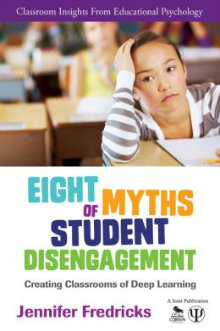Overcome 8 Myths of Student Disengagement
Eight Myths of Student Disengagement: Creating Classrooms of Deep Learning
By Jennifer A. Fredricks
(Corwin, 2014 – Learn more)
 Reviewed by Joy Kirr
Reviewed by Joy Kirr
Student choice = student engagement, correct? What more could I need? Something. Even with various ways for students to choose in my ELA class, including time for them to pursue their own passions, I still have disengaged students. This book was calling out to me to read it, and I found it very valuable.
If you’ve ever had one of these thoughts, it’s time to pick up Eight Myths of Student Disengagement by Jennifer A. Fredricks for yourself:
- I cannot always identify students who are disengaged. Some may be pulling the wool over my eyes, and I’m okay with that. As long as they’re doing the work, right?
- I’ve got that student that “just doesn’t care.” I can only do so much. Even if I stood on my head, she wouldn’t be engaged in the lesson.
- My students are in too many activities outside of school that conflict with the work they should be doing IN class.
- If I provide a “hook” and let the students work hands-on (with music, no less!), that should get them all engaged.
- They say if students are working together, they learn more. My students perform better when it’s quiet. They follow directions better, resulting in more learning.
- I can’t engage EVERY student. There are too many factors that contribute to their disengagement.
 The three portraits of engagement Fredricks shares in the first chapter helped me place my current students into categories and better recognize the different types of engagement. We all have those students who are “behaviorally engaged” — a.k.a. “compliant” — but not fully engaged. We also have those that find school boring and/or struggle with the content.
The three portraits of engagement Fredricks shares in the first chapter helped me place my current students into categories and better recognize the different types of engagement. We all have those students who are “behaviorally engaged” — a.k.a. “compliant” — but not fully engaged. We also have those that find school boring and/or struggle with the content.
Each following chapter uses these portraits to show how students behave at each level of engagement and gives the possible reasons why they would have these behaviors. What stuck in my head was how “the rich get richer and the poor get poorer” when it comes to engagement in school.
Those who are engaged tend to associate with others who are already engaged, and it propels them even closer to successes each year. Those who are not engaged, for whatever the reason, have a tendency to become less and less engaged, especially as they get older.
The “answers” are here
If you care for your students and they KNOW it, you are on your way to keeping them engaged in school. In each chapter Fredricks provides strong research to prove what strategies and activities are engaging and which are detrimental to student engagement.
There is a strong case for giving students choice, with examples of how this can be done in a practical sense provided alongside. Readers can tell that this book was written by an educator, for educators. I felt it was especially aimed at middle school teachers, as the psychology of adolescents really comes into play when we’re figuring out student engagement.
Adding ideas to my practice
I have to admit that many of the philosophical ideas I’ve been learning about online and applying in my classroom this year were supported – with research! Ideas were reinforced in my head while I devoured this book, and I needed to stop reading often in order to include them in my current lessons or share them with coworkers.
I am now encouraged to have more group work (using the practical tactics/hints provided), seek ways for students to share with the larger community, sit down and talk more often with “difficult” students, and provide more opportunities for IN class activities to have more in common with OUT of school activities. (There are valid reasons presented for this, as Fredricks explains why children are so engaged in activities outside of school!) Ideas such as problem- or passion-based learning were also supported in many ways, from the first chapter to the last.
Not every bit of each chapter applied to students in my demographic, but that means this book will be even more valuable for teachers who have students at high risk for dropping out. Fredricks analyzes the behaviors that lead to students leaving school and presents ideas for helping those students succeed.
Joy Kirr currently teaches 7th grade LA & Literature in a suburb of Chicago. She was first a special education teacher working with deaf & hard-of-hearing students, and next became a reading specialist and nationally board certified. This is her 20th year of teaching, but she keeps learning more about education and children, so it’s always like her first!

































